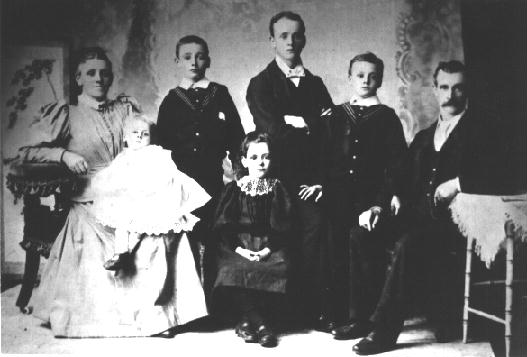JMF genealogy

Biography: Margaret Scott Ballantyne (1855-1930)
Margaret Scott Ballantyne
(c1855-1930)
Basic information about this person: \click here\
Margaret Scott Ballantyne was born in Scotland, lived in Australia for twenty years before living for nearly thirty in New Zealand.
Her paternal great grandfather (Thomas Ballantyne) was probably a cousin of her maternal great grandfather (Andrew Ballantyne), because they both came from East Kilbride where she was born on 6 January 1855. The family lived in and around Mearns (Renfrewshire) when she was an infant, but later moved north of the River Clyde to Bushyhill (Cambuslang) and, later, Tollcross. Her father was a baker.
When she was twelve years old her mother died suddenly from an infected abscess on her thigh. There is little doubt that the infection resulted from the very poor level of housing and sanitation that prevailed in this area.
Four years later the 16-year-old Margaret was her father's housekeeper at Asforths Land in Old Monkland. When her father died from a stroke two years later, Margaret was suddenly head of the household and de facto mother to her younger siblings. The youngest, Jean, was just 10 years old.
As a 22-year-old, Margaret married Charles Fleming at Tollcross on 28 December 1877. He too was the de facto male head of his household, because his father had abandoned the family many years earlier. He was an iron moulder, as were his brothers. Their mother Elizabeth Fleming (nee Taylor) had managed to hold her family together without the support of her husband.
On the eve of their first wedding anniversary, Margaret and Charles produced a son who was names Charles Taylor Fleming after his father's maternal grandfather. Two years later a second son was born who was named for Christina's father, Thomas Ballantyne Fleming. Four months later Margaret's live-in mother-in-law died. She and her husband Charles were the family elders at just 26 years old.
Later that year their second son fell ill and died of fluid on the brain, probably a secondary infection caused by measles. Their oldest son was also infected, but recovered.
It was probably the deaths of Elizabeth Fleming and Thomas Ballantyne Fleming that finally resolved Margaret and Charles to emigrate to Australia. Eighteen months after their son died they boarded the Eastern Monarch bound for Townsville in Queensland. Charles recorded in his diary:
we arrived all safe on board the En Monarch between 3 and 4 Oclock, their was great confusion until we got our births secured, and our beds arranged, we were very fortunate in getting a good birth it is one of the top ones with a window looking right into it, i waited up that night to about 20 minutes from 12pm when the tug began to tough us away then we went to our bed but i got up with my knees on my bed and my face to the window watching the wellknown shore til we passed Rothsey bay i then lay down and slept sound to 5.30am. I got up then and saw the tug leaving us at 6am.
Margaret was expecting their third son who was born on 13 August as the ship crossed the equator in the Atlantic ocean. Charles recorded the event as follows:
at 11=20 Oclock tonight i acompanied her to the stair leading to the hospital at half past 10 pm and about a quarter from 12 pm the chief mate despatched a message informing me of what had taken place we are only one days sail from the line if he is spared he can boast of being born this near the centre of the world.
You can read a full transcript of Charles Fleming's shipboard diary in Townsville or Hell!
The ship reached Townsville on the 23rd October after a dangerous and eventful voyage. All passengers and crew were quarantined on Magnetic and Ross Islands for three weeks due to a measles epidemic that had broken out on board as the ship sailed up the Australian coast. Fortunately, neither of the couple's sons succumbed to the disease, probably due to immunity built up from young Charles' earlier infection - the one that killed his brother Thomas.
Charles found work at the local foundry but, after a week, he decided to seek work in Brisbane because his skills were not being used at Townsville. He quickly discovered that there were no vacancies to be had in Brisbane and so tried at Maryborough with no luck still. After visiting Maggie's aunt at Gympie, the family returned to Maryborough where Charles accepted unskilled work at the foundry.
Fleming family group, circa 1893
Maggie with baby Elizabeth (1892), William (1883), Christina (1888), Charles Taylor (1878), Angus (1886), Charles Snr
The family soon moved to Sydney where Charles found skilled work in Sir Samuel Mort's iron foundry. During the next few years, Maggie gave birth to three more children: Angus (1887) was named for his uncle who died in the year of his birth, Christina (1888) and Elizabeth (1892) who were named for their maternal and fraternal grandmothers respectively.
All of Charles Fleming's siblings also emigrated to Australia over the next few years, with the exception of his youngest brother Matthew who lived out his life in Glasgow where he became a chemist with his own shop. Charles brother Angus died suddenly from an aneurism in 1887 and is buried in Sydney's Rookwood cemetery.
Family lore holds that Charles was responsible for making the figurehead for the Sydney pilot boat Captain Cook but was incensed that Sir Samuel Mort did not afford him the recognition that was his due. He resigned from his position at the foundry and decided to emigrate to New Zealand. The truth is a little different - see my essay Charles Fleming and the Captain Cook II.
The whole extended family (except for eldest son Charles Taylor Fleming) emigrated to New Zealand in about 1903 and settled in the Thames District, where Charles and Maggie lived for the rest of their lives.
Charles died on 17 August 1928 and his wife, Margaret, on 23 November 1930. They are buried in Shortland Cemetery at Thames.
